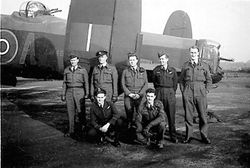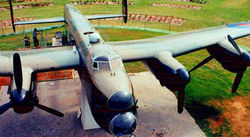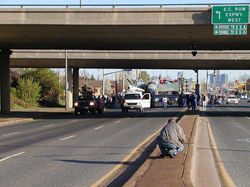

How Windsor Got Its Lancaster
From “Lancaster Bomber Recollections” by the late Harry O. Brumpton, former Commissioner, Windsor Dept. of Parks & Rec., 1959-1982
The Lancaster FM 212, on display in Windsor's Jackson Park for several decades, has been removed for restoration.
Early in the 1960s, a great deal of public interest was generated locally in the disbandment of the RCAF’s remaining Lancaster Squadrons. Following the preparation of a favourable study, City Council approved the purchase of a Bomber for the sum of $1,250.
Following negotiations with War Assets of Canada, our initial task was to fly up to Dunnville, Ontario and select a Lancaster from the many that were stored at that abandoned airfield. The selection presented no problem due to the fact that, unlike all the other Lancasters, which were stored on the open tarmac, FM212 was housed indoors in a mothballed condition. In actuality, FM212 was airworthy and could have been readied for flight at an estimated cost of $10,000.
Yard owner Capt. George Dilts was a true entrepreneur of the old school. When pressed for a price to move the bomber from Dunnville to Windsor, Capt. Dilts dropped to the shop floor and there with a piece of chalk quickly computed a price for all to see of $3000, which was acceptable to everyone present.
Captain Dilts’ trip to Windsor on August 29th, 1964 was memorable. He had removed the wings of the aircraft and stored them alongside the fuselage of the aircraft which had been pushed aboard the barge. The four motors were put aboard in their heavy tank-like containers. The whole entourage of tugs and barge then began a challenging voyage across Lake Erie and up the Detroit River to Windsor. Dilts nearly lost his load twice due to rough seas.
FM212 was partially re-assembled at the riverfront site primarily for the purpose of generating public interest in the fundraising programme. A single wing, along with one motor, were mounted on the aircraft by Parks mechanics. It was a debilitating sight to see our once proud Lancaster perched on the river’s edge minus a wing and three motors – sort of like a plucked turkey.
Once ashore, the Lancaster was readied for public inspection at 25 cents per head. A fixed stairway was constructed leading into the cockpit through the forward escape hatch. Eventually, funds in the amount of $20,000 were raised for the construction of the plinth in Jackson Park.
Once the plinth was completed, it became necessary to move the bomber from its location on the riverfront in downtown Windsor to Jackson Park, some two miles distant. The move was accomplished at night under the direction of a local house mover. Fortunately, the route led straight from the river up our main street, Ouellette Avenue, directly to Jackson Park. Mid-winter was chosen as the time for the move so that the heavy bomber could be towed across the frozen park without causing damage to the turf. With the aircraft finally home, it was then locked down and the engines and props were reinstalled.
Over time, the Lancaster began looking wear for wear. The Canadian Historical Aircraft Association was formed in Windsor in 1992 and officially incorporated as a non-profit organization in 1995. Arrangements for a cooperative work program with the City of Windsor were made and volunteers began working on basic maintenance and modest restoration efforts in September of 1993. Volunteers replaced many missing components of the aircraft including a new cockpit canopy and bomb aimers nose blister. The engines were inhibited against corrosion yearly to prevent them from seizing.
Unfortunately, due to further deterioration of the aircraft, it was removed from its pedestal on May 26th, 2005, and replaced with two full scale replica WWII memorial aircrafts, the Spitfire and the Hurricane. FM212 is to be restored for future viewing in a yet-to-be determined controlled environment.
 |  |  |
|---|---|---|
 |  |  |
 |  |  |
 |  |  |
 |  |  |
 |  |  |
 |  |  |
 |  |
|---|---|
 |  |
 |  |
 |  |
 |  |
 |  |
 |  |
 |  |
 |  |
 |  |
 |  |
 |  |
 |  |
 |  |
 |  |
 |  |
 |  |
 |  |
 |  |
 |  |
 |  |
 |  |
 |
